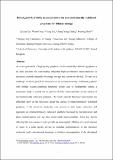Files in this item
Direct growth of SnO2 nanocrystallites on electrochemically exfoliated graphene for lithium storage
Item metadata
| dc.contributor.author | Xu, Zexuan | |
| dc.contributor.author | Yue, Wenbo | |
| dc.contributor.author | Lin, Rong | |
| dc.contributor.author | Chiang, Chang-Yang | |
| dc.contributor.author | Zhou, Wuzong | |
| dc.date.accessioned | 2020-01-07T00:36:16Z | |
| dc.date.available | 2020-01-07T00:36:16Z | |
| dc.date.issued | 2019-02 | |
| dc.identifier | 257319093 | |
| dc.identifier | 3b97556e-cfdc-4105-9f1e-b586f46881ac | |
| dc.identifier | 85059505105 | |
| dc.identifier | 000459203100057 | |
| dc.identifier.citation | Xu , Z , Yue , W , Lin , R , Chiang , C-Y & Zhou , W 2019 , ' Direct growth of SnO 2 nanocrystallites on electrochemically exfoliated graphene for lithium storage ' , Journal of Energy Storage , vol. 21 , pp. 647-656 . https://doi.org/10.1016/j.est.2019.01.001 | en |
| dc.identifier.issn | 2352-152X | |
| dc.identifier.other | ORCID: /0000-0001-9752-7076/work/62668234 | |
| dc.identifier.uri | https://hdl.handle.net/10023/19234 | |
| dc.description | This work was financially supported by National Natural Science Foundation of China (21573023). WZ thanks EPSRC’s support to the electron microscopy Laboratory for a Capital Equipment Grant EP/L017008/1. | en |
| dc.description.abstract | As a new generation of high quality graphene, electrochemically exfoliated graphene is an ideal platform for constructing integrated high-performance nanocomposites as advanced electrode materials for energy storage and conversion devices. To take on a challenge of direct growth of nanoparticles on electrochemically exfoliated graphene with limited oxygen-containing functional groups and its hydrophobic nature, a systematic study is carried out on growth of SnO2 nanocrystallites on the surface of electrochemically exfoliated graphene. The results indicate that these nanocrystals can efficiently grow on the functional group-free surface of electrochemically exfoliated graphene, if the precursor molecules can polymerize into larger molecules and aggregate on electrochemically exfoliated graphene followed by decomposition and phase transformation into the final metal oxide nanocrystallites. Some key factors affecting this non-classical crystal growth are investigated. Addition of a small amount of water in a polar aprotic solvent to stimulate polymerization of the precursor molecules and a solvothermal treatment to facilitate decomposition of the disordered aggregates of the polymerized precursors are crucial to the growth of nanocrystals on electrochemically exfoliated graphene. The improved electrical conductivity and structural stability of the hybrids may promote the performance of the materials in various applications, such as exceptional lithium storage capability. | |
| dc.format.extent | 10 | |
| dc.format.extent | 3209250 | |
| dc.language.iso | eng | |
| dc.relation.ispartof | Journal of Energy Storage | en |
| dc.subject | Electrochemically exfoliated graphene | en |
| dc.subject | Tin dioxide | en |
| dc.subject | Polymerization | en |
| dc.subject | Crystal growth | en |
| dc.subject | Lithium-ion battery | en |
| dc.subject | QD Chemistry | en |
| dc.subject | NDAS | en |
| dc.subject | SDG 7 - Affordable and Clean Energy | en |
| dc.subject.lcc | QD | en |
| dc.title | Direct growth of SnO2 nanocrystallites on electrochemically exfoliated graphene for lithium storage | en |
| dc.type | Journal article | en |
| dc.contributor.sponsor | EPSRC | en |
| dc.contributor.institution | University of St Andrews. EaSTCHEM | en |
| dc.contributor.institution | University of St Andrews. School of Chemistry | en |
| dc.identifier.doi | https://doi.org/10.1016/j.est.2019.01.001 | |
| dc.description.status | Peer reviewed | en |
| dc.date.embargoedUntil | 2020-01-07 | |
| dc.identifier.grantnumber | ep/l017008/1 | en |
This item appears in the following Collection(s)
Items in the St Andrews Research Repository are protected by copyright, with all rights reserved, unless otherwise indicated.

